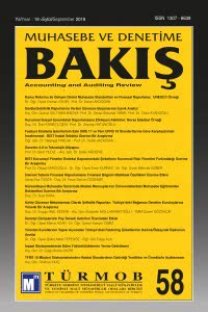TÜRKİYE’DE BAĞIMSIZ DENETÇİLERİN HİLE RİSK FAKTÖRLERİ ETKİ DEĞERLEMESİ
Bu çalışma SAS No.99 ve benzeri düzenlemelerin ekinde yer alan ve hile risk değerlendirmelerinde kullanılanhile risk faktörleri konusunda Türk denetçilerin değerlemelerini ortaya çıkarmayı ve ilgili meslek mensuplarınındeğerlemeleri ile karşılaştırmayı amaçlamaktadır. Türk denetçileri tutum ve rasyonalizasyon koşulları ile ilgilifinansal raporlama risk faktörlerine daha çok önem veriyor görünmekte ve fırsat ve ortam koşulları ile ilgili varlıkların kötüye kullanılması hile risk faktörlerini daha etkili olarak değerlenmektedir. Her ne kadar yerel denetçilerin değerlemeleri yabancı meslektaşlarından biraz farklılık gösterse de, bir bütün olarak Türk denetçilerin değerlemeleri iç ve dış denetçiler ile adlî muhasebeciler gibi hile ile ilgili meslektaşlarının değerlemeleri ile genel olarak uyumlu bulunmaktadır. Başka bir anlatımla, Türk denetçileri Cressey’in hile üçgeninin köşelerinioluşturan koşullardan habersiz değildir ve bu noktadan müşteri işletmeler tarafından kontrol edilebilen ve edilemeyen koşulların bilincinde olduğu ve hile olaylarına karşı alınan önlemlerin söz konusu koşullardan etkilendiğini düşündüğü çıkarımı yapılabilmektedir. Öte yandan, Türk denetçileri fırsat ve ortam ile ilgili koşullar özelolarak iç kontrollar ve genel olarak kontrol çevresi ile yakından ilişkili olduğundan varlıkların kötüye kullanılması hilelerinin önlenmesi ve ortaya çıkarılmasında fırsat ve ortam koşulları ile ilgili risk faktörlerinin en etkilifaktörler olduğunu değerlendirmektedir
Anahtar Kelimeler:
Hile Risk Faktörleri, Hile Risk Değerlemesi, Bağımsız Denetçilerin Değerlemeleri, İç Denetçilerin Değerlemeleri, Adlî Muhasebecilerin Değerlemeleri
EXTERNAL AUDITORS’ IMPACT ASSESSMENT OF FRAUD RISK FACTORS IN TURKEY
This research aims at discovering Turkish auditors’ weights for risk factors i.e. red flags annexed to SASNo.99 and similar regulations and used in their fraud risk assessments and compare them with relevant professionals’ weights. They seem to attach more importance to financial reporting fraud risk factors involving attitude&rationalisation conditions and find asset misappropriation fraud risk factors involving opportunity conditions more effective than others. Though local auditors’ weights slightly differ from those of their foreign counterparts in Turkey, Turkish auditors’ assessment as a whole is generally compatible with that of other fraud-related professionals, which consists of internal&external auditors and forensic experts. In other words, they arenot unaware of the type of conditions each represented by the corners of Cressey’s fraud triangle, which mightalso imply that Turkish auditors are conscious of conditions which can or cannot be controlled by the clientcompanies themselves, and think countermeasures taken by them against fraud incidents affected by the type ofthese conditions. On the other hand, they consider opportunity conditions to be the most effective risk factorsin preventing and detecting asset misappropriation frauds, because opportunity conditions are closely relatedwith internal controls in particular and control environments in general
Keywords:
Fraud Risk Factors, Fraud Risk Assessment, External Auditors’ Weights, Internal Auditors’ Weights, Forensic Experts’ Weights,
___
- ACFE, (2008), 2008 ACFE Report to the Nation of Occupational Fraud & Abuse, Association of Certified Fraud Examiners”, 2008, Austin, USA.
- APOSTOLOU, Barbara, John M. Hassell ve Sally A. Webber, (2001), Management Fraud Risk Factors: Ratings by Forensic Experts, The CPA Journal, October 2001.
- BIEGELMAN, Martin T. ve Joel T. Bartov, (2006), Executive Roadmap to Fraud Prevention and Internal Control:Creating a Culture of Compliance, 2006, John Wiley & Sons, Hoboken, New Jersey, USA.
- BOYNTON, William and Raymond N.Johnson, (2006), Modern Auditing:Assurance Services And The Integrity of Financial Reporting, 8th Edition, 2006, John Wiley & Sons, Hoboken, New Jersey, USA.
- CHURCH, Bryan K. Jeffrey, J.Mcmillan ve Arnold Schneider, (2001), Detection of Fraudulent Reporting, Journal of Accountancy, September 2001.
- CHURCH, Bryan K., Jeffrey Mcmillan ve Arnold Schneider, (2001), “Factors Affecting Internal Auditors’ Consideration of Fraudulent Financial Reporting during Analytical Procedures”, Auditing:A Journal of Practice & Theory, March 2001, Vol.20, No.1, pp.65-80.
- COENEN, Tracy, (2008), Essentials of Corporate Fraud, , John Wiley & Sons, Hoboken, New Jersey, USA.
- COLBERT, Janet L. ve Brian S.Turner, “Strategies for Dealing with Fraud”, The Journal of Corporate Accounting, May/June 2000.
- DAUBER, Nick, Anique Ahmed Quareshi, Marc H. Levine ve Joel G.Siegel, (2005), 2006 Auditing Standards, Thompson, Ohio.
- GOLDEN, Thomas W. Steven, L. Skalak ve Mona M. Clayton, (2006), A Guide to Forensic Accounting Investigation, John Wiley & Sons, Hoboken, New Jersey, USA.
- GRAMLING, Audrey A. ve Patricia M. Myers, (2003), “Internal Auditors’Assessment of Fraud Warning Signs : Implications for External Auditors”, The CPA Journal, June 2003, pp.20-24.
- İSLAMOĞLU, Ahmet Hamdi, (2003), Bilimsel Araştırma Yöntemleri, İstanbul: Beta Basım Yayım Dağıtım.
- LOEBBECKE, James K., Martha M.Eining ve John J. Willingham, (1989), “Auditors’ Experience with Material Irregularities:Frequency, Nature, and Detectibality, Auditing:A Journal of Practice&Theory, Vol.9, No.1, Fall 1989.
- MAJID Abdul, Ferdinand A. Gul ve Judy S. L. Tsui, (2001), An Analysis of Hong Kong Auditors’ Perceptions of the Importance of Selected Red Flag Factors in Risk Assessment, Journal of Business Ethics 32.263-274, 2001.
- MONTGOMERY, Daniel D., Mark S. Beasley, Susan L. Menelaides ve Zoe-Vonna Palmrose, (2002), “Auditors’ New Procedures for Detecting Fraud”, Journal of Accountancy, May 2002.
- RAMOS, Michael, (2008), Wiley Practioner’s Guide to GAAS 2008, John Wiley & Sons, Hoboken, New Jersey, USA
- REINSTEIN, Alan ve Jeffrey J.McMillan, (2004), The Enron Debacle: More than a Perfect Storm”, Critical Perspectives on Accounting, 15(2004) 955-970.
- REZAEE, Zabihollah, (2002), The Three Cs of Fraudulent Financial Reporting, Internal Auditor, October 2002.
- SINGLETON, Tommie W., Aaron Singleton, G.Jack Bologna ve Robert J. Lindquist, (2006), Fraud Auditing and Forensic Accounting, John Wiley & Sons, Hoboken, New Jersey, USA.
- SINGLETON, Tommie, (2002), “Stop Fraud with Powerful Internal Controls”, The Journal of Corporate Accounting&Finance, May/June 2002.
- ZIMMELMAN Mark F., (1997), “The Effects of SAS No.82 on Auditors’ Attention to Fraud Risk Factors and Audit Planning Decisions”, Journal of Accounting Research, Vol.35, Supplement 1997.
- ISSN: 1307-6639
- Yayın Aralığı: Yılda 3 Sayı
- Başlangıç: 2000
- Yayıncı: TÜRMOB
Sayıdaki Diğer Makaleler
Meral EROL FİDAN, Smmm Hasan CİNİT
ETİK LİDERLİK VE ÖRGÜTSEL BAĞLILIK İLİŞKİSİ: MUHASEBE BÜROLARINDA ÇALIŞANLAR ÜZERİNE BİR ARAŞTIRMA
UMS 12 GELİR VERGİLERİ STANDARDI KAPSAMINDA MALİ KAR VE TİCARİ KAR İLE ERTELENMİŞ VERGİLER
TÜRKİYE’DE BAĞIMSIZ DENETÇİLERİN HİLE RİSK FAKTÖRLERİ ETKİ DEĞERLEMESİ
KARŞILIKLAR, KOŞULLU BORÇLAR VE KOŞULLU VARLIKLARIN TMS 37 STANDARDI KAPSAMINDA İNCELENMESİ
